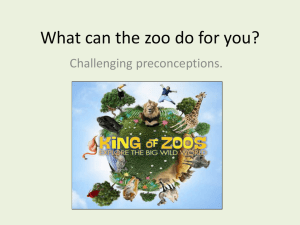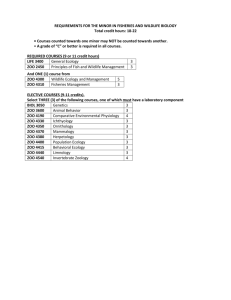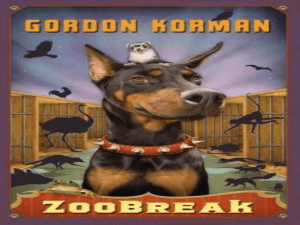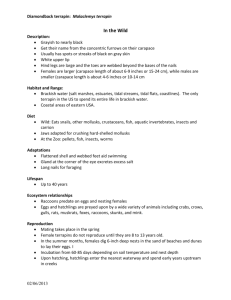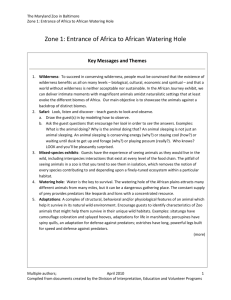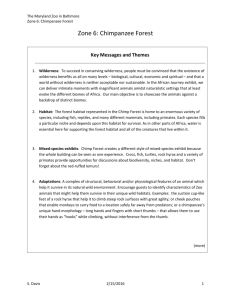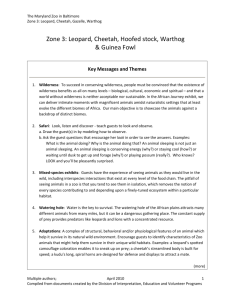Our Changing World A School-based citizen science program with
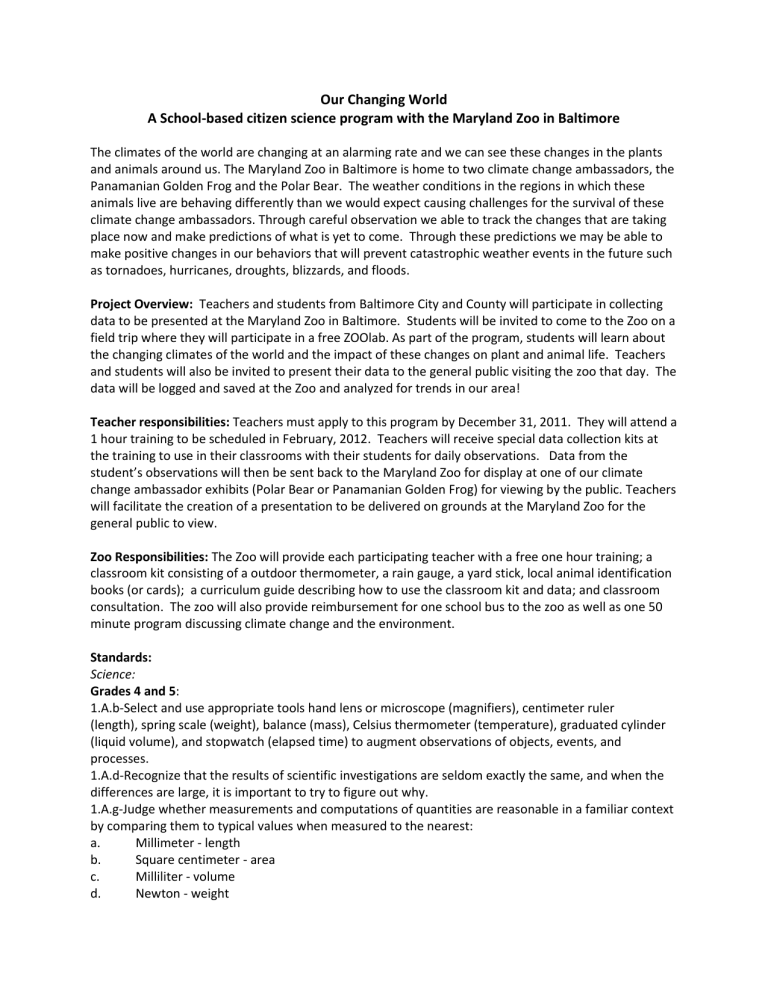
Our Changing World
A School-based citizen science program with the Maryland Zoo in Baltimore
The climates of the world are changing at an alarming rate and we can see these changes in the plants and animals around us. The Maryland Zoo in Baltimore is home to two climate change ambassadors, the
Panamanian Golden Frog and the Polar Bear. The weather conditions in the regions in which these animals live are behaving differently than we would expect causing challenges for the survival of these climate change ambassadors. Through careful observation we able to track the changes that are taking place now and make predictions of what is yet to come. Through these predictions we may be able to make positive changes in our behaviors that will prevent catastrophic weather events in the future such as tornadoes, hurricanes, droughts, blizzards, and floods.
Project Overview: Teachers and students from Baltimore City and County will participate in collecting data to be presented at the Maryland Zoo in Baltimore. Students will be invited to come to the Zoo on a field trip where they will participate in a free ZOOlab. As part of the program, students will learn about the changing climates of the world and the impact of these changes on plant and animal life. Teachers and students will also be invited to present their data to the general public visiting the zoo that day. The data will be logged and saved at the Zoo and analyzed for trends in our area!
Teacher responsibilities: Teachers must apply to this program by December 31, 2011. They will attend a
1 hour training to be scheduled in February, 2012. Teachers will receive special data collection kits at the training to use in their classrooms with their students for daily observations. Data from the student’s observations will then be sent back to the Maryland Zoo for display at one of our climate change ambassador exhibits (Polar Bear or Panamanian Golden Frog) for viewing by the public. Teachers will facilitate the creation of a presentation to be delivered on grounds at the Maryland Zoo for the general public to view.
Zoo Responsibilities: The Zoo will provide each participating teacher with a free one hour training; a classroom kit consisting of a outdoor thermometer, a rain gauge, a yard stick, local animal identification books (or cards); a curriculum guide describing how to use the classroom kit and data; and classroom consultation. The zoo will also provide reimbursement for one school bus to the zoo as well as one 50 minute program discussing climate change and the environment.
Standards:
Science:
Grades 4 and 5:
1.A.b-Select and use appropriate tools hand lens or microscope (magnifiers), centimeter ruler
(length), spring scale (weight), balance (mass), Celsius thermometer (temperature), graduated cylinder
(liquid volume), and stopwatch (elapsed time) to augment observations of objects, events, and processes.
1.A.d-Recognize that the results of scientific investigations are seldom exactly the same, and when the differences are large, it is important to try to figure out why.
1.A.g-Judge whether measurements and computations of quantities are reasonable in a familiar context by comparing them to typical values when measured to the nearest: a.
Millimeter - length b.
c.
Square centimeter - area
Milliliter - volume d.
Newton - weight
e.
f.
g.
Gram - mass
Second - time
Degree C – temperature
1.B.a-Develop explanations using knowledge possessed and evidence from observations, reliable print resources, and investigations.
1.B.b-Offer reasons for their findings and consider reasons suggested by others.
1.B.d-Keep a notebook that describes observations made, carefully distinguishes actual observations from ideas and speculations about what was observed, and is understandable weeks or months later.
1.C.a-Make use of and analyze models, such as tables and graphs to summarize and interpret data.
1.C.c-Submit work to the critique of others which involves discussing findings, posing questions, and challenging statements to clarify ideas.
Grade 4 Only
2.E.2a-Describe different seasonal weather conditions using data collected from weather instruments, models or drawings.
2.E.2b-Compare average daily temperatures during different seasons.
2.E.2d-Compare average daily precipitation during different seasons. a.
b.
Amount
Type
3.F.1a-Identify and describe the interactions of organisms present in a habitat. a.
Competition for space, food, and water b.
Beneficial interactions: nesting, pollination, seed dispersal, oysters filtering as in the Chesapeake
Bay, etc. c.
Roles within food chains and webs: scavengers, decomposers, producers, consumers.
3.F.1b-Explain that changes in an organism's habitat are sometimes beneficial to it and sometimes harmful.
6.B.1a-Identify and describe that human activities in a community or region are affected by environmental factors a.
Presence and quality of water b.
Soil type c.
d.
Temperature
Precipitation
Grade 5 Only:
3.A.1.a-Identify and describe features and behaviors of some of the plants and animals living in a familiar environment and explain ways that these organisms are well suited to their environment.
3.A.1.b-Based on information about the features and behaviors of animals and plants from very different environments describe reasons that they might not survive if their environment changed or if they were moved from one environment to another.
3.A.1.e-Explain that the survival of individual organisms and entire populations can be affected by sudden (flood, Tsunami) or slow (global warming, air pollution) changes in the environment.
6.B.1.a-Identify and describe personal and community behaviors that waste natural and/or cause environmental harm and those behaviors that maintain or improve the environment .
Math
Grade 4 and Grade 5:
3.A.1- Read customary and metric measurement units
4.A.1-Collect, organize and display data
Social Studies:
Grade 4:
3.A.1-Use geographic tools to locate places and describe the human and physical characteristics of those places.
3.B.1- Describe similarities and differences of regions by using geographic characteristics.
Grades 6-8:
1.A.1-Design, analyze, or carry out simple investigations and formulate appropriate conclusions based on data obtained or provided.
1.A.1.d-Locate information in reference books, back issues of newspapers, magazines and compact disks, and computer databases.
3.F.1-Give reasons supporting the fact that the number of organisms an environment can support depends on the physical conditions and resources available.
3.F.1.a-Explain that populations increase or decrease relative to the availability of resources and the conditions of the environment.
6.B.1-Recognize and explain that human-caused changes have consequences for
Maryland's environment as well as for other places and future times.
6.B.1.b-Recognize and describe how environmental change in one part of the world can have consequences for other parts of the world.
6.B.1.c-Identify and describe that ecosystems can be impacted by human activities. a.
Protection of the Chesapeake Bay watershed b.
Resource acquisition and use c.
Land use decisions (agriculture, mining, and development) d.
Recycling e.
Use and disposal of toxic substances


